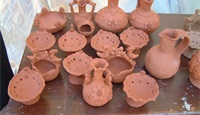
Applicant:
Phini Community Council
Communities Concerned - Bearers of the element:
Phini Community Council, Theophanis Pilavakis (owner of the Pilavakeion Museum), Giota Aristidou Demosthenous (owner of pottery workshop in Phini), Phini Association of Emigrants and Friends.
Domain of Intangible Cultural Heritage:
Traditional craftsmanship
Date of inscription:
2017
Geographical distribution:
The traditional art of pottery from Phini is identified in this community in a specific form. In the past the Phini art of pottery was transmitted to the neighbouring settlements of Agios Demetrios and Kaminaria which, with the passage of time, have adapted it to a tradition of their own. In Phini, the art of pottery was for a large number of inhabitants an income-generating profession. Men were mainly “pithos-makers”, in other words they were making the large earthenware bulk storage vessels, whereas women were making mainly containers for transporting and keeping commodities and water. Nowadays the women of Phini preserve the traditional art of Phini pottery by making utility but mainly decorative pots made of red clay.
Brief description:
Nowadays, thanks to the significant contribution of the Phini Community Centre and the Phini Diaspora Association, there is a pottery workshop in the village in order to preserve the art of pottery and pass it on to the younger generations. The proof of the art and fame of Phini is the well-known Phini pot which used to be depicted on the £0.10 cent coin until it went out of circulation with the changeover to the Euro.
There are four steps in the production of the traditional red clay pots in the Phini community:
-
The clay soil is mined, collected and transported to the village following which it is processed.
-
Preparation of the clay
Once the clay soil has been processed (beating and sifting), the clay is prepared by mixing clay soil with water. For small decorative vessels the clay may be kneaded by hand in small quantities. For making large pithos vessels the needs for clay are much larger, so the clay is wedged or kneaded in a special trough using a wooden shovel.
-
Pottery making
Hand-made vessels are shaped by hand and/or by using the primitive pottery wheel.
-
Firing of the pots
The vessels are fired in a traditional kiln.